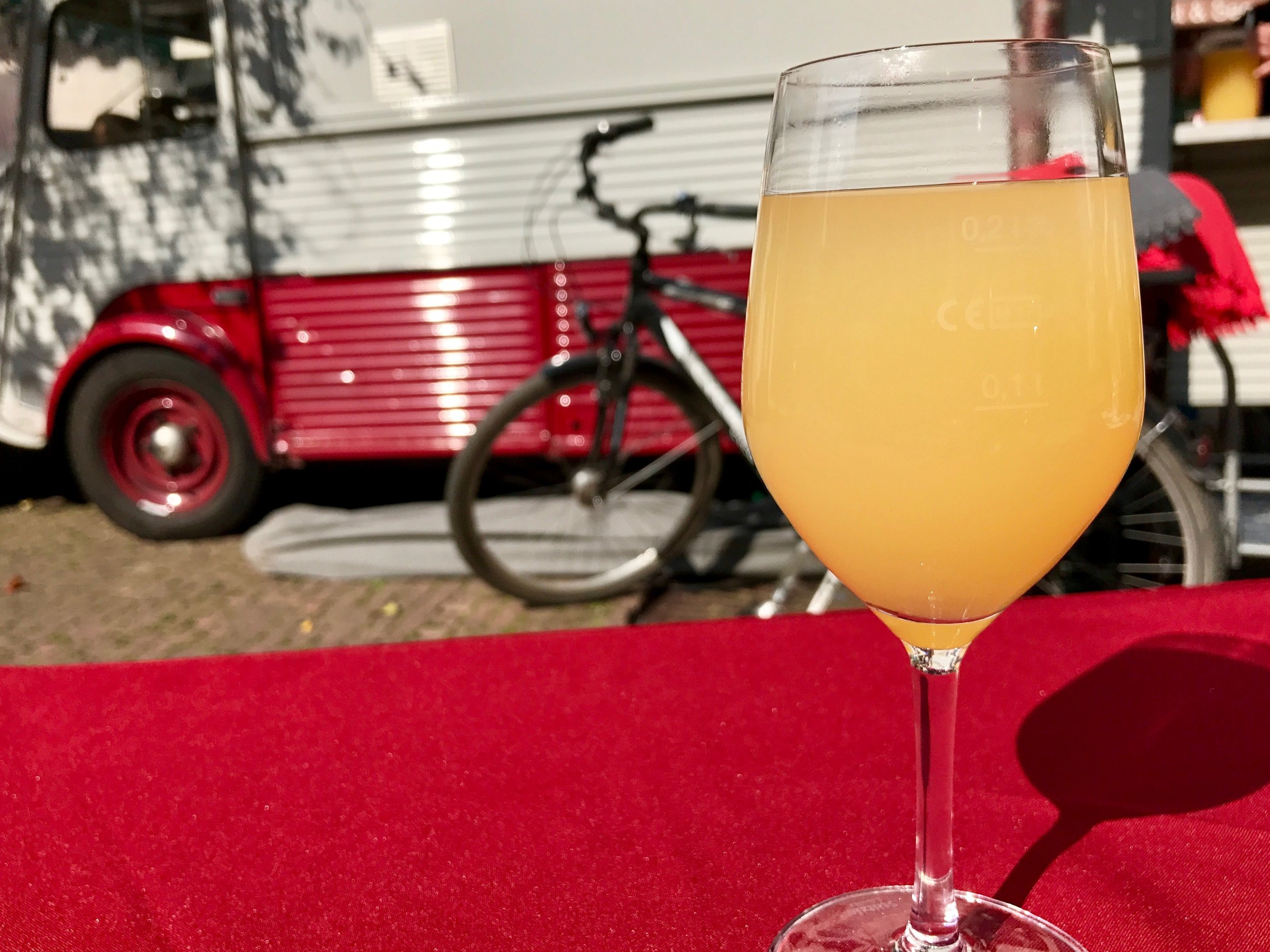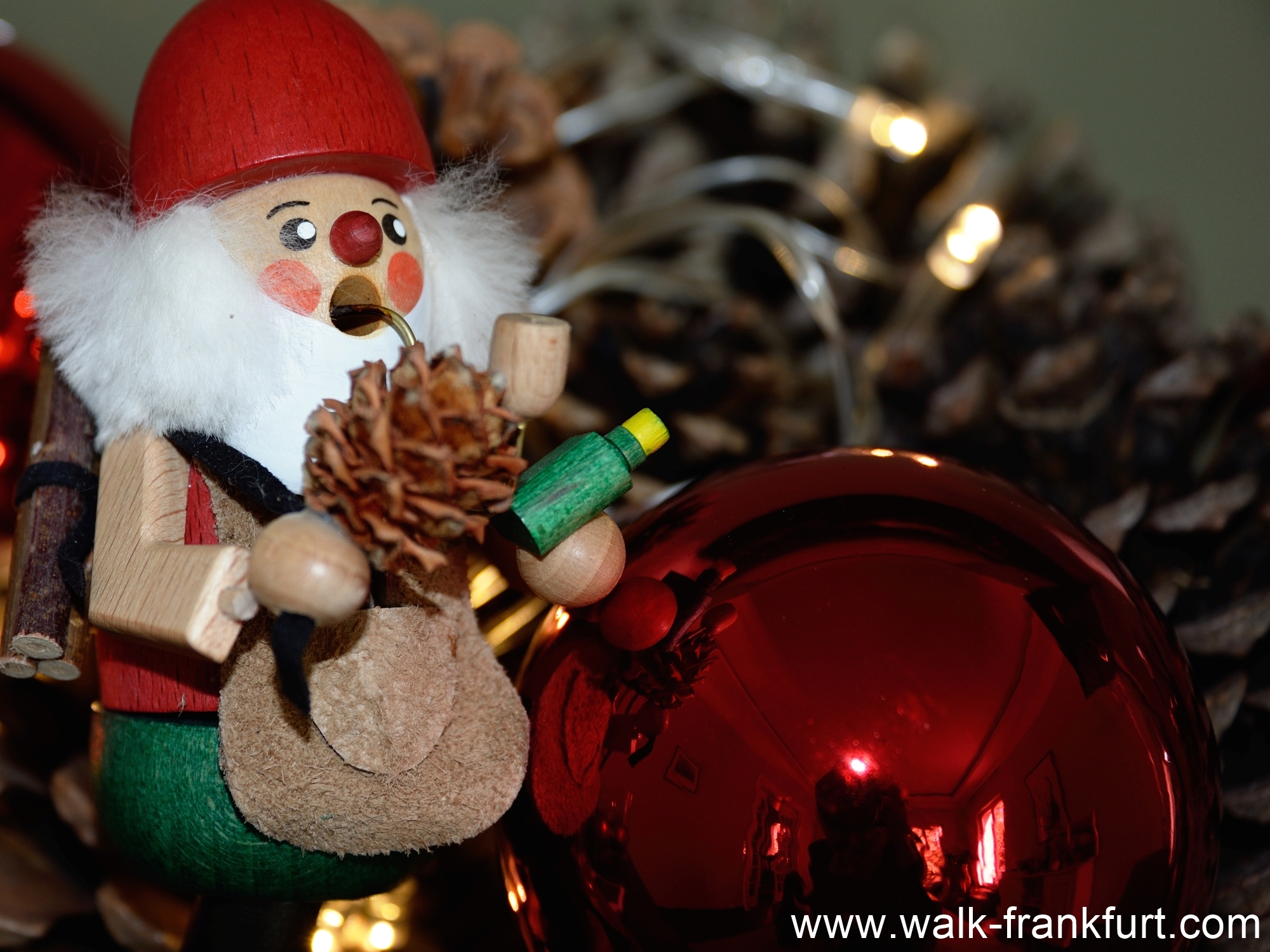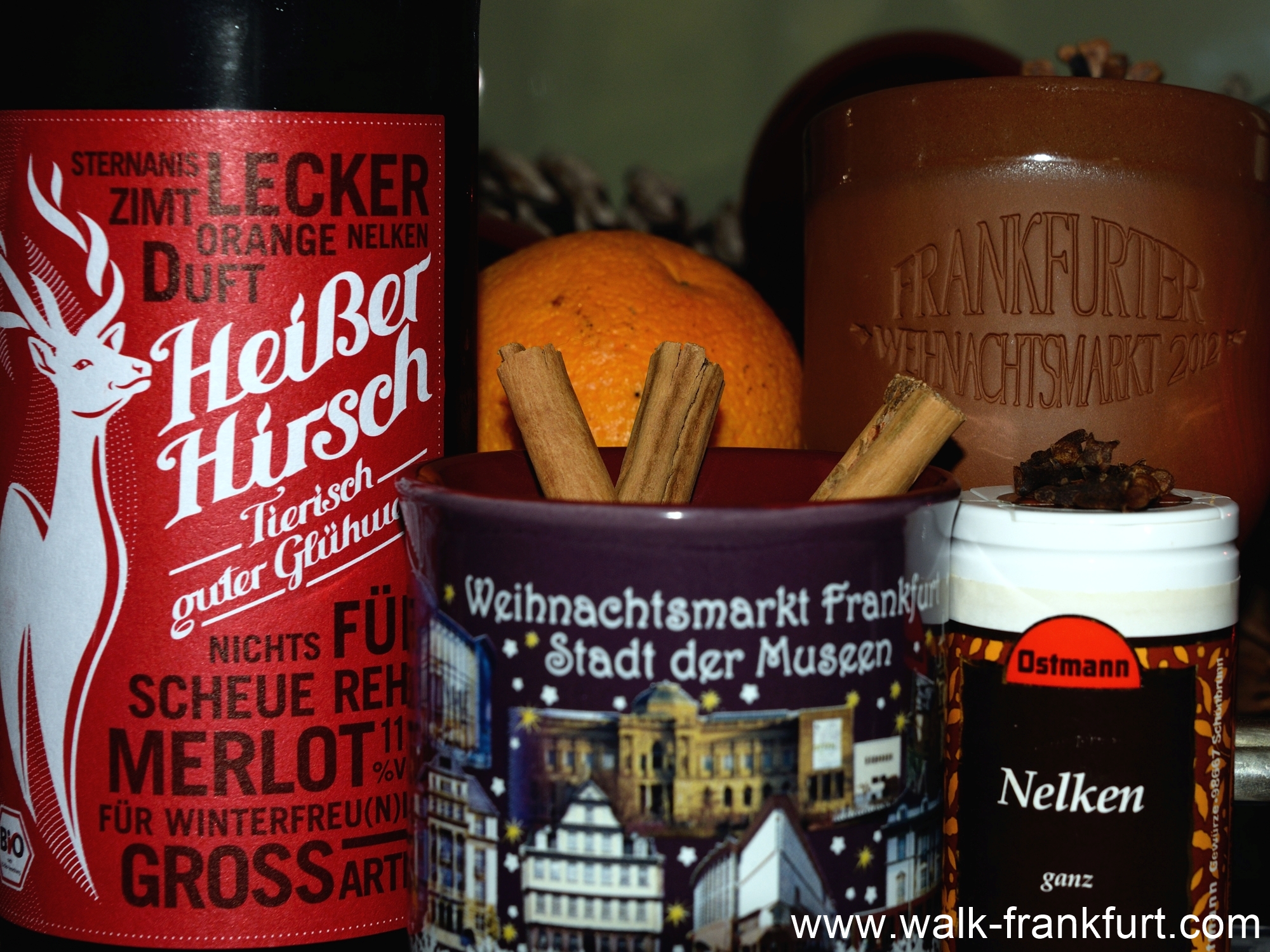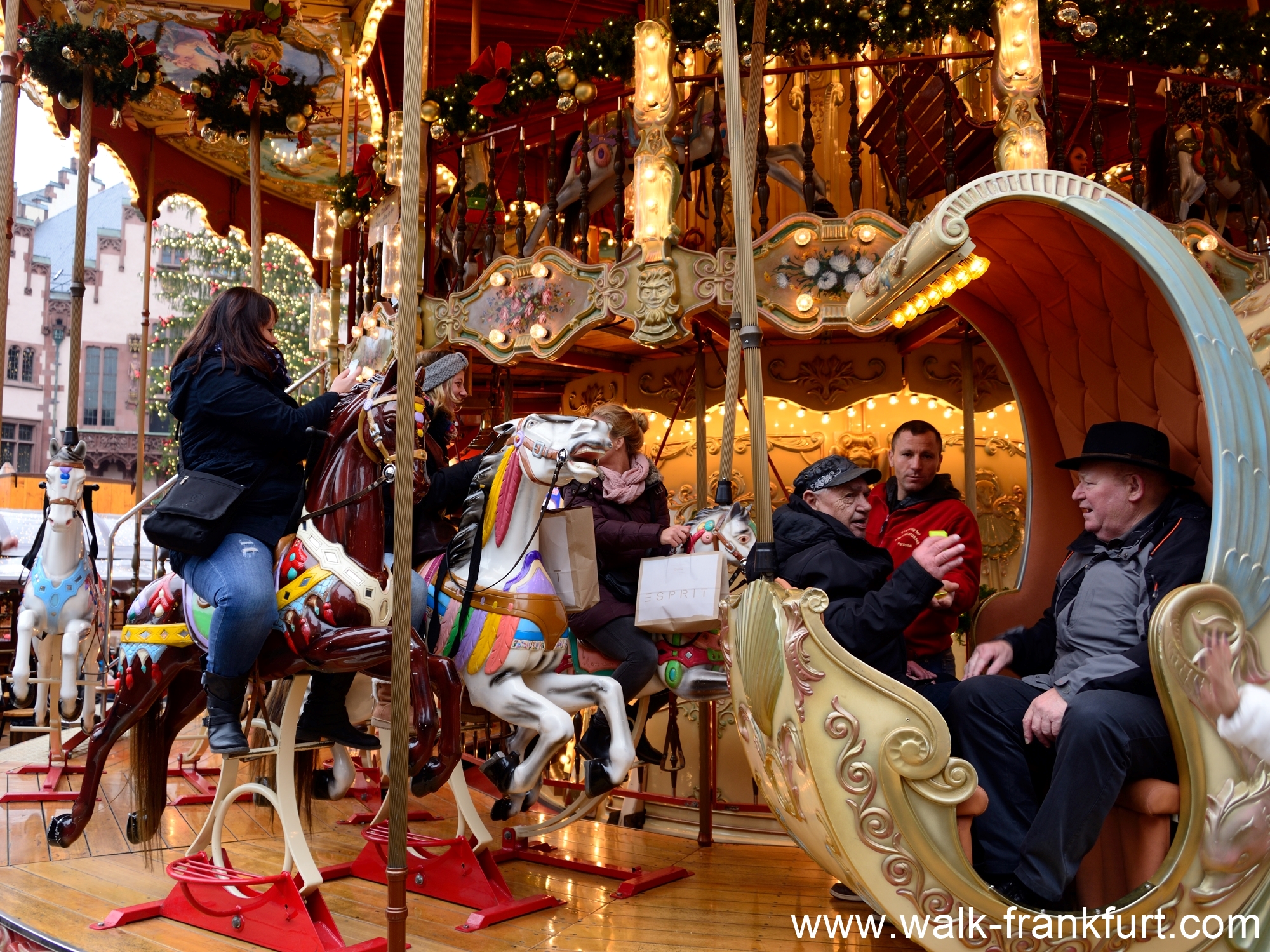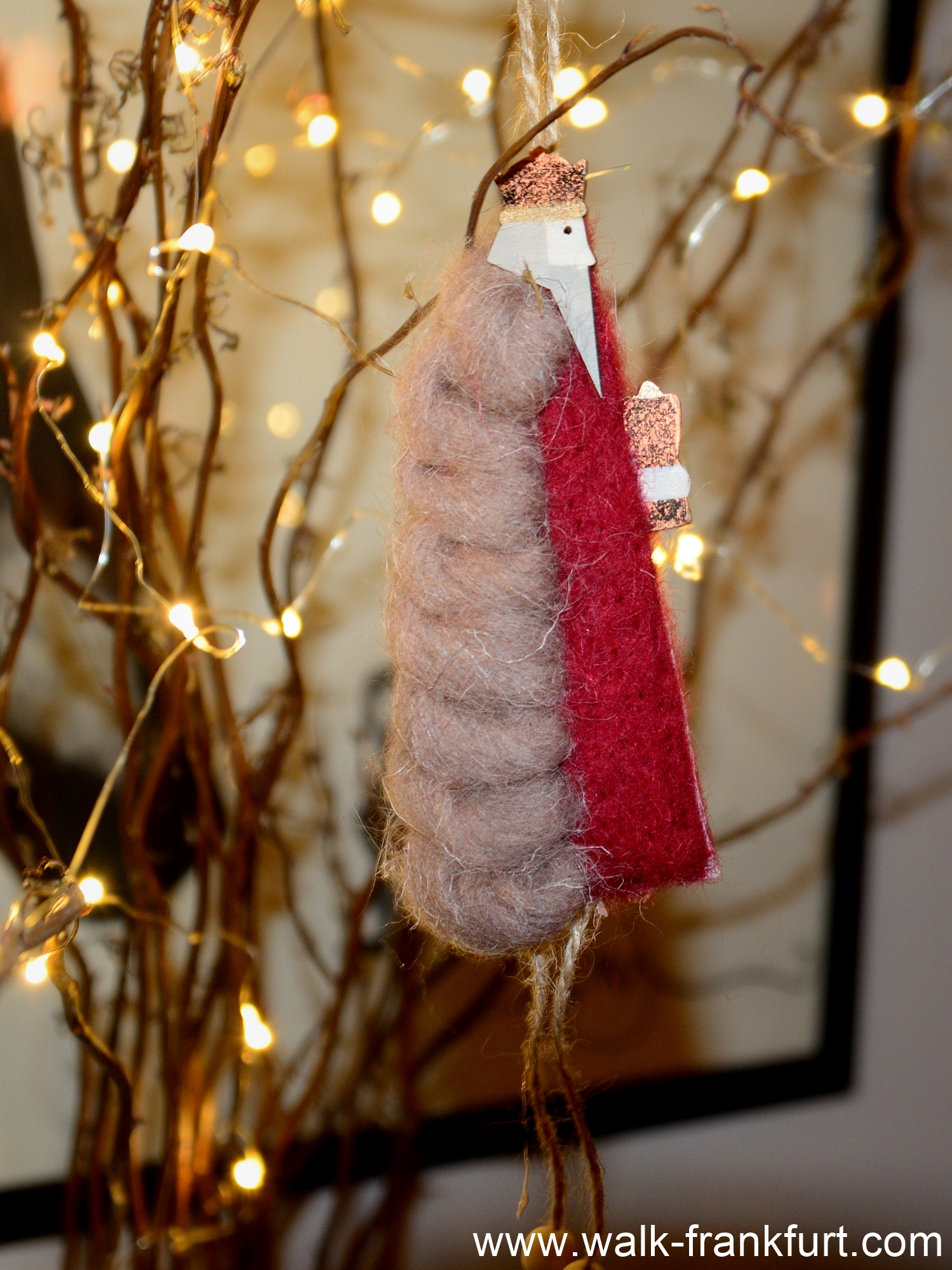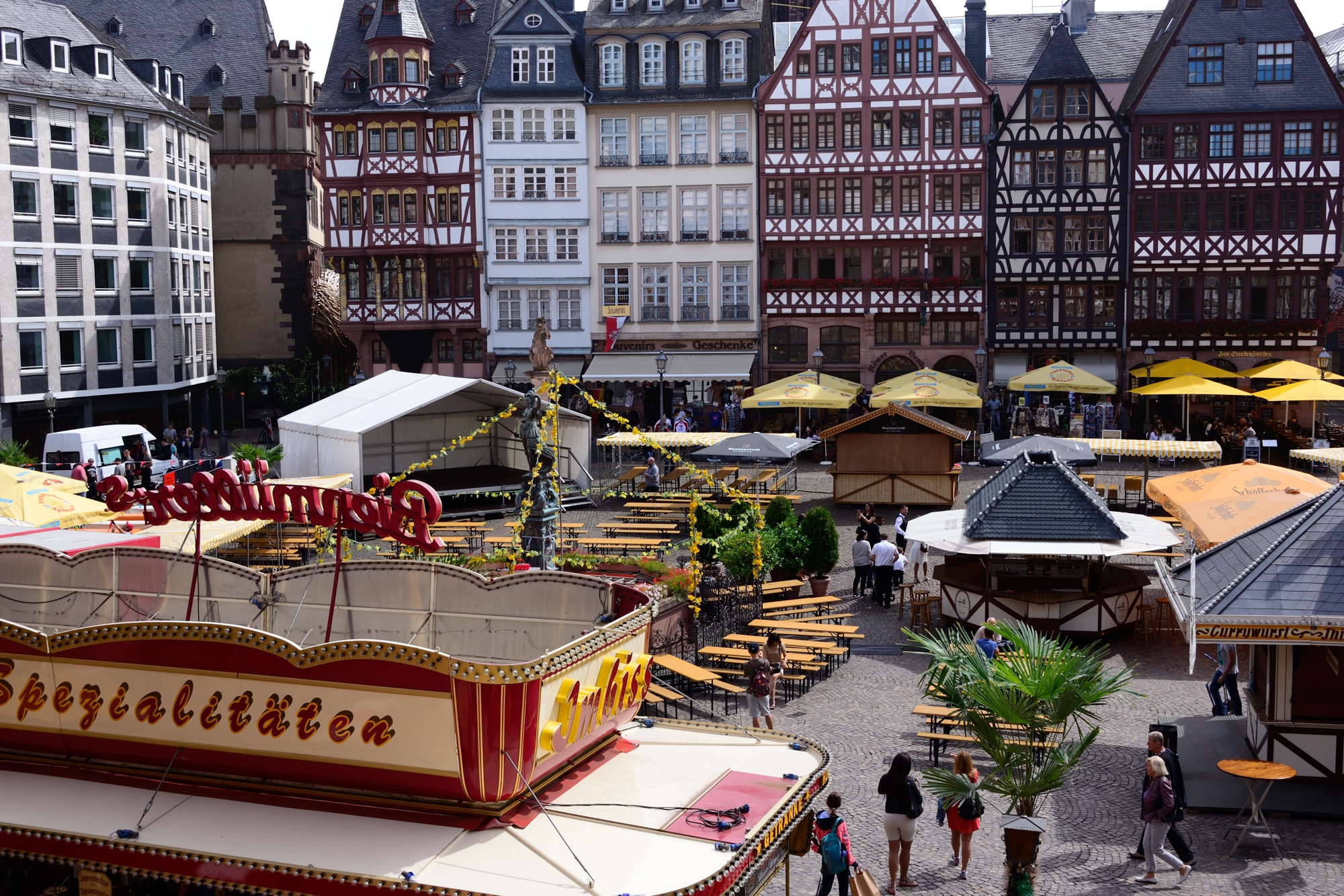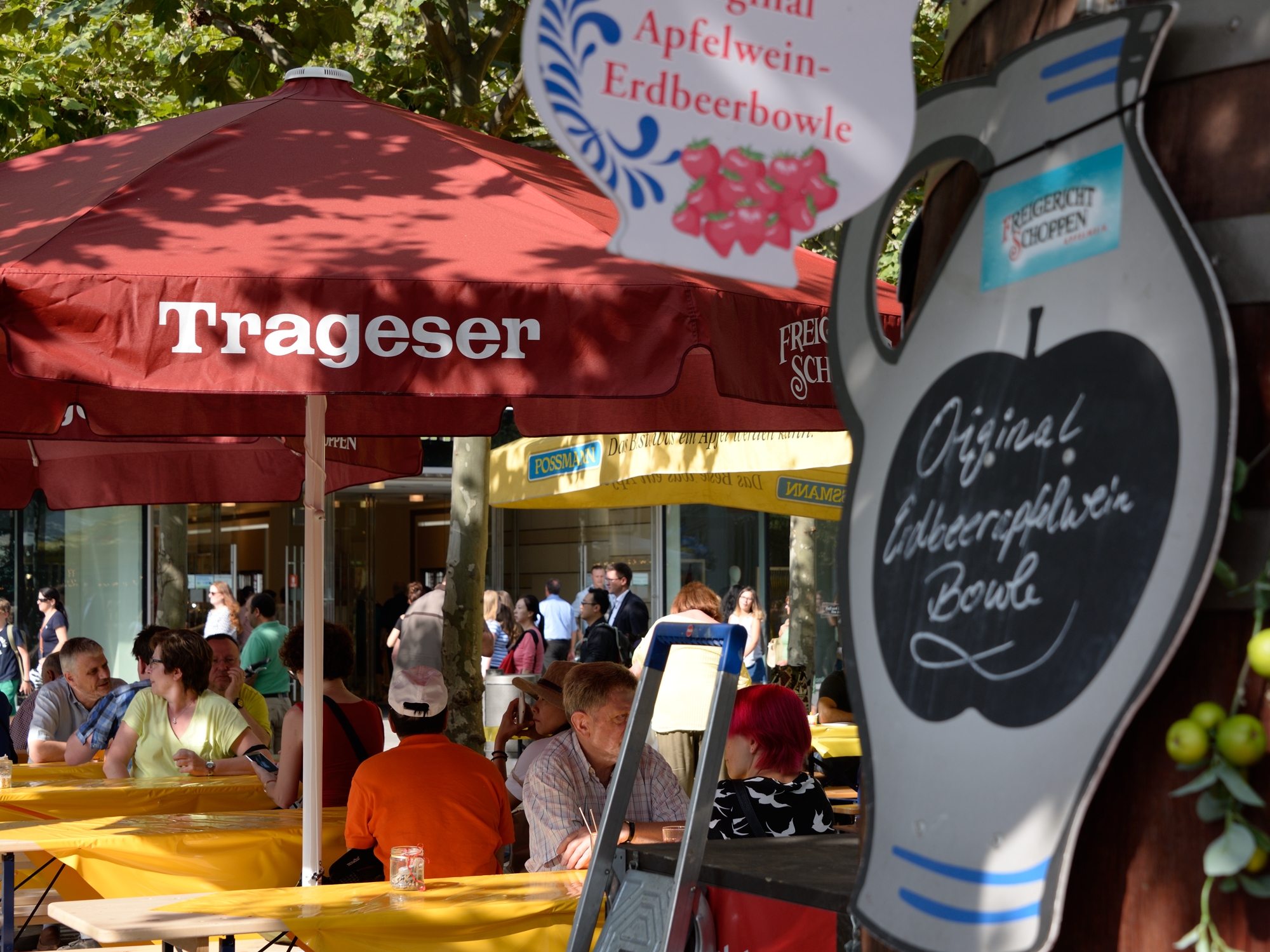Federweisser - a special wine available after the grape harvest
What is Federweisser?
Federweisser suddenly appears at the end of September in towns and cities within the German wine regions. Some towns host a Federweisser Fest whilst in cities like Frankfurt Federweisser appears at the local farmer's markets. The season is short, so enjoy it while you can.
Federweisser is known as "new" wine. After the juice has been extracted from the harvested grapes, yeast is added to the must (juice) and fermentation begins. As fermentation progresses, the alcohol levels are monitored and once they reach 4%, the juice can be drunk in the form of Federweisser. The wine is still actively fermenting, so expect a glass of cloudy, refreshingly prickly wine which has a natural sweetness to it. The name means "feather white" and derives from the white'ish appearance of small yeast particles floating in the glass which, some say, looks like small white feathers. Don't be fooled by it's sweet taste though, Federweisser can achieve an alcohol content of up to 10%.
Federweisser - cloudy in appearance and naturally sweet
In the Rhineland you'll see Federweisser written Federweißer. In other regions it is also known as Süßer, Sauser and Neue Wein. Roterweisser is the same product but made from red grapes hence it has a deep pink appearance. Because the wine is still fermenting and releasing carbon dioxide, bottles cannot be fully sealed and are left partially open to let the gas escape. As a result transportation of Federweisser is a delicate business and this is why it is rarely available outside of the wine regions. Occasionally you can find a bottle in local supermarkets, but be warned - if the bottle is unsealed (a sign of good quality) you'll have to carry your precious cargo upright all the way home!
Traditionally Zwiebelkuchen (onion cake) is eaten with Federweisser and it's a heavenly combination. The Rhineland version of Zwiebelkuchen is a thin base of bread like dough topped with a good depth of soft, sweet onions, sautéed with speck and a sprinkling of caraway seeds. This recipe http://mybestgermanrecipes.com/german-onion-tart/ is the most authentic I have found.
Where to find Federweisser in Frankfurt
In Frankfurt the Liebfrauenberg is hosting a 10 day Federweisser Fest starting on September 27th 2024. Federweisser is also available at the Rollanderhof wine outlets at the Kleinmarkthalle, the Thursday and Saturday farmer's market on Konstablerwacher and the weekly market on Schillerstraße (details about market days can be found here). In addition, Weinschirn, Römerberg 8 (an excellent wine bar close to the cathedral), stocks Federweisser so there is plenty of opportunity to try the new wine before the season finishes!
Rollanderhof, above the back exit of the Kleinmarkthalle, serving Federweisser!
Heidelberg audio tour - cafes and other recommendations!
What makes Heidelberg so unique? Why does it feel so different to other German towns? Walking along the narrow streets you will hear how French troops burned Heidelberg to the ground and then about its re-birth as a baroque city, "beautiful and straight". The baroque features of the buildings then spring to life all around, as do the hidden remnants of the former medieval Heidelberg. Discover why there are so many madonnas in Heidelberg often perched above looking down upon the busy shoppers below and what the bronze monkey represents.
Student life features strongly in Germanys oldest university city:
- a student union canteen in an old medieval stable, - a dedicated student prison, - a new university building built around an old medieval witches tower, - a library in the architectural wilhelmian style, - famous students, both good and bad.
Heidelberg didn't escape the effects of World War Two either. Discover the book burning memorial and and stumble stones and the site of the old jewish synagogue, and who actually blew up the old bridge. Discover the influence the Americans have on this city too, both before and during the war.
Download the Voicemap tour and start discovering and exploring!
Updated 16.02.2025
The suggestions below follow the same route as the voicemap audiotour, downloadable by following the link, plus a few extra hints and tips. If you spot a change, perhaps a new cafe you tried and liked, please leave a comment.
Cafes etc.
Key to listings: D - dining, C - cafe/coffee, Vg - vegan, TG - to go, W - wine
Along the tour route:
D Vetters Alt Brauhaus - (Steingasse 9) A clasic brewery serving it’s own beers and hearty plates of German food. Open for lunch and dinner until late.
C, D, W Cafe Burkhardt (Untere Str. 27) Originally a wine bar Cafe Burkhardt is now the place to go for lunch or a bite to eat, especially for a choise of vegetarian food or gluten-free options.
C Ahmed's Middle Eastern Eatery (Untere Str. 23) Opening post lunch time and staying open until late, popular with the students, Ahmed’s serves very good falafel amongst other hearty plates of food. Plenty of vegetarian options.
D, C Rada Coffee & Rösterei (Untere Str. 21) For a great cup of coffee this is the place to head too. Home made cakes including gluten free options, too. Better still, they also offer gluten free lunch options.
C, TG OK Kool (Marstallstr. 7) The place for some great home made ice-cream, cakes and a good cup of coffee too, Limited opening hours, though!
C, TG, Moro Caffe & Thé (Haupstr. 160) Long time known as the coffee shop in Heidelberg. Stop here for a perfectly made cappuccino and a (large) piece of home made cake.
Slightly off the audio tour route:
D Mahmoud's Altstadt - (Merianstr. 3) Slightly off the audio tour track, but located on a nice quiet back street, Mahmound’s is known for it’s middle eastern food, fresh salads and falafel.
C Panno (Ingrimstr. 22) On the street leading to the funicular railway up to the castle, this tiny cafe serves excellent coffee and great cakes too. Very chilled!
D Kulturbrauerei (Leyergasse 6) Yes, it is popular with the tourists, but the Kulturbrauerei has a lovely garden in the summer months, and brews it’s own beer.
W Weinstube Witter (Hauptstr. 224) A lovely old wine bar, with a lovely choice of local wines by the glass, and some small bites for when you suddenly realised you’ve been here a lot longer and perhaps drunk a glass or two more than planned :-)
Souvenirs
Letter & Co (Untere Str. 24) for a slightly different Heidelberg souvenir, this shop proudly stocks Kaweco pens, a firm which was originally founded in Heidelberg 1883.
Käthe Wohlfahrt (Hauptstr. 124) a dedicated Christmas shop selling german made Christmas decorations all year round.
University Souvenirs (Augustinergasse 2) Purchase Heidelberg university t-shirts, mugs and hats at the Student Karzer.
Heidelberg Castle
A trip to Heidelberg is not complete without a trip to the castle. Walking up is one option and there are various routes, the most common being the path next to the funicular railway.
The grounds of the castle are free to explore and offer some lovely views. To enter the castle you will need to purchase a ticket. Alternatively take the funicular railway (Bergbahn) up and entrance to the castle is included.
The funicular railway can be found at the corner of Kornmarkt and Burgweg/Zwingerstrasse. Ticket prices and other information are detailed in the link.
Special delights at the Frankfurt Christmas Market
The 2018 Frankfurt Christmas Market from November 26th to December 22nd. One of the oldest , most traditional Christmas markets in Germany.
Winter is coming and so are the Christmas markets. Frankfurt am Main hosts an extensive, nostalgic (it dates back to the 14th century) Christmas market running from the Hauptwache, down the Neue Krämer and into the heart of the old town. Glühwein on every corner, roasted chestnuts, kartoffelpuffer (aka potato cakes) and other local delicacies provide sustenance as you wander through the fair.
The Christmas Market at the heart of the old town by the town hall
Many stalls proudly sell traditional, German crafted, wooden decorations from the Erzgebirge region. Directly outside St. Paul's a stall sells the grey and blue pottery associated with the city's apple wine taverns, and next door stands Wagner's Honey House. It's an original 300 year old timber-frame house erected especially for the Christmas market to sell all manner of honey based products.
At the heart of the old town, on Römerberg, stands the Christmas tree fulling the criteria that it must be at least as high as the roof of the town hall. Decorated with over 5000 lights it makes a spectacular centre piece. Below it is the nativity scene and nearby stands the beautifully restored carousel which delights both children and adults alike.
For a typical Frankfurt gift, seek out the baked marzipan Brenten and Bethmännchen. Stranger still are the Quetschemännchen, little figures made from dried fruits and nuts. Tradition has it that a suitor would give his sweetheart a Quetschemännchen to show his affection. If the young lady kept the gift then her heart was his but, if she sent it back he had not secured her love. Not to worry, a glass or two of Glühwein and friendly camaraderie would help him get over the rejection, especially if he headed to the Weinschirn, at the back of the Christmas market towards the cathedral, where many local Frankfurters congregate for the best glühwein in the city.
Just when you think you have exhausted the Christmas market and are heading home, steer course towards Friedrich-Stoltze-Platz and you'll stumble into yet more revelry. The square is decked with pink tables and benches and surrounded by a variety of food and drink stalls and is the perfect place to stop, eat and soak up (or further ignite) the evening's excesses. Here you will find the best Feuerzangenbowle. What is that you ask? Atop a huge cauldron of Glühwein hangs a rum soaked sugar loaf which is set alight and gently drips it's caramelised syrup into the wine below. Served with a slice of orange, it's glühwein with an extra punch!
PS: Each year Frankfurt issues a new Glühwein mug. You pay a deposit for the mug when you buy your Glühwein, so no one minds if you simply keep the mug as a souvenir.
Still not ready to go home? Then head to the Weihnachtshütte at the Thurn & Taxis Palais which stays open until 11pm.
This link offers a map of all the Christmas Market locations mentioned in the above article.
This link lists special events at the Christmas Market, by date.
Keep an eye on my Facebook page over the coming weeks where I'll be offering insights to the best Christmas stalls and features during this year's Christmas Market.
Frankfurt Christmas Market Carousel (Its not just for Children!)
Festivals in and around Frankfurt during Summer 2019
A list of (mainly wine) festivals local to Frankfurt, sorted by date from July to October.
As you can imagine festivals are very much about food and drink, but some are dedicated to the local Rheingau wine. Whatever the festival there will always be plenty of food, plenty of drink and live music to dance away the warm summer evenings to.
In this list, festivals are listed by date and every festival is either in Frankfurt or is easily accessed by public transport. I've added a few notes about trains, but please check the RMV website for full details. If you want to explore every regional wine festival this summer, then the Rheingau Wein Fest brochure is a must! An additional resource is the Weinwanderung website where you can search for vineyard walks by region.
Festivals in June - July
26 June - 7 July - Frankfurt Opera Square Fest, at the Alte Oper. Lots of food and drink stands, plus entertainment starting at lunchtime and into the evening.
4 - 8 July - Darmstadt Heinerfest, opens at 18:00 on July 4th. An amazing array of events and attractions during this 5 day festival hosted all around Friedensplatz, with a firework display on Monday evening. (Numerous regional and S-bahns depart Frankfurt Hauptbahnhof on a regular basis)
5 - 8 July - Eltville Sekt & Biedermeier Festival, This is a lovely festival along the Rhein promenade at Eltville, celebrating the sparkling wine of the region. The link also contains details of all other wine festivals in the Rheingau region. (RB10 regional train departs Frankfurt Hauptbahnhof every hour)
6 - 15 July - Frankfurt Höchst Altstadt Fest. Taking place at the Schloss and Justinusplatz. Daily from 1pm - midnight. Lots for the family to enjoy (S1 & S2 departs Frankfurt Hauptbahnhof regularly throughout the week)
12 - 15 July - Wiesbaden Schierstein Harbour Fest, Wiesbaden-Ost. A festival along the Habour promenade with plenty of music, food and drinks. On Saturday morning there is a flea-market, and throughout the weekend a dragon boat regatta. (Wiesbaden-Ost is the closest station. S1, S8, S9 depart Frankfurt Hauptbahnhof every 15 min)
12 - 15 July - Hochheimer Wine Fest, hosted in the old town of Hochheim. A chance to try Queen Victoria's favourite wine! (S1 departs Frankfurt Hauptbahnhof every 15 min throughout the week)
19 - 21 July - Frankfurt Christopher Street Day, Frankfurt. The main parade is on Saturday starting at Römerberg. Festivities all weekend long around Grosse Friedberger Strasse.
19 - 22 July - Geisenheimer Lindenfest. A wine festival hosted in the Geisenheim cathedral square and special opening of shops on Sunday 16th too. (Regional RB10 departs Frankfurt Hauptbahnhof for Geisenheim Bahnhof every hour throughout the week)
19 July - 4 Aug - Frankfurt Sommerwerft Theatre Fest - along the northern banks, near Weselerwerft, of the Main river a festival of theatre and events for all the family. Of course they'll be drinks and food too!
20 - 21 July - Amazing Thailand Fest, Bad Homburg. A weekend of Thai celebrations, arts and food, hosted in the the Kurpark. (S5 departs Frankfurt Hauptbahnhof every 15 min on weekdays, every 30 mins at the weekend)
26 - 28 July - Mainz Light Fest All along the Rheinufer you will find food and drink stalls as you enjoy the festival of lights. Special ships are chartered to view the lights from the river and there is a spectacular firework and laser show on the Saturday evening. (S8 departs Frankfurt Hauptbahnhof every 30 min throughout the week)
26 - 29 July - Frauensteiner Weinfest, Wiesbaden. Hosted on St. Georg and Katharina Platz, Georg Str. 2 in the centre of Wiesbaden. (Wiesbaden Hauptbahnhof is the closest station. S1, S8, S9 depart Frankfurt Hauptbahnhof every 15 min)
26 Jul - 4 Aug - Dietzenbach Wine Fest Taking place on Europaplatz in the heart of Dietzenbach this festival draws vintners from around the region. Lots of live music. Opens at 5pm every day. (S2 departs Frankfurt Hauptbahnhof every 15 min on weekdays, every 30 mins at the weekend)
Festivals in August
Until 4 Aug - Dietzenbach Wine Fest Taking place on Europaplatz in the heart of Dietzenbach this festival draws vintners from around the region. Lots of live music. Opens at 5pm every day. (S2 departs Frankfurt Hauptbahnhof every 15 min on weekdays, every 30 mins at the weekend)
Until 4 Aug - Frankfurt Sommerwerft Theatre Fest - along the northern banks, near Weselerwerft, of the Main river a festival of theatre and events for all the family. Of course they'll be drinks and food too!
2 - 4 Aug - Frankfurt Street Food Fest hosted at Hauptwache in the centre of the city, pretty hard to miss! Great selection of foods and drinks. (Numerous S-Bahns and U-Bahns travel through Hauptwache every minute of the day)
2 - 4 Aug - Oberursel Weinfest hosted on the Marktplatz. (S5 departs Frankfurt Hauptbahnhof every 15 min on weekdays, every 30 mins at the weekend)
2 - 4 Aug - Wallufer Weindorf A wine festival in the oldest wine producing village of the Rheingau. Hosted along the river bank at La-Londe-Platz, Walluf. (Regional RB10 departs Frankfurt Hauptbahnhof every hour throughout the week)
2 - 5 Aug - Frankfurt Main River Fest Hosted along the northern bank of the Main River, by the Eisener Steg in the heart of the old town. Funfair rides and lots of fun for the family. Firework display on Monday (7th) night.
3 -4 Aug - Kronberg Art and Wine Fest. A weekend of festivities starting at 3pm on Saturday until 8pm and Sunday from 11am - 7pm. Stores are open on Sunday too! (S4 to Kronberg departs Frankfurt Hauptbahnhof every 30 min throughout the week)
9 - 11 Aug - Frankfurt Main-Matsuri Fest. The 2nd Main-Matsuri Fest in Frankfurt, hosted on the Walther-von-Cronberg Platz in Sachsenhausen. Full program details are in the link.
9 - 18 Aug - Frankfurt Applewine Fest. A celebration of apple wine takes place on Roßmarkt with multiple producers selling many varieties of apple wine. This blog post offers a guide to the apple wine varieties.
9 - 18 Aug - The Rheingauer Weinfest in Wiesbaden One of the largest wine festivals in the World which takes place at Wiesbaden’s Schlossplatz and Dern’sches Gelände. (Wiesbaden Hauptbahnhof is the closest station. S1, S8, S9 depart Frankfurt Hauptbahnhof every 15 min)
11 Aug - Tomaten Fest at Gärtnerei Schecker, in Oberrad. Buy tomatoes by the basket full and snack on tomato based fare all around this wonderful hof. (The roads get very busy , so it’s best to cycle or take the tram to Wiener Str. and walk up)
15 Aug - Frankfurt Bahnhofsviertalnacht starting at 7pm. Roads are closed and the Bahnhofsviertal streets are handed over to the people of Frankfurt - drinks, food and music into the early hours.
16 - 18 Aug - Frankfurt 529th Fountain Festival in Sachsenhausen. A festival in old Sachsenhausen, celebrating the purity of the old water fountains. Yes, it has live music, food, drinks and a party atmosphere all weekend.
17 - 18 Aug - Frankfurt Bockenheim Weinfest, Weingarten, Bockenheim. Go along to Bockenheim and support their 3rd wine festival!
23 - 25 Aug - Frankfurt Museumsuferfest starting at 3pm on Friday and finishing with fireworks on Sunday night. Stalls of arts, crafts and old books along the Museumsufer. Whilst on the riverside on both the north and south side of the Main river are music, food and drink booths.
28 Aug - 6 Sept - Frankfurt Rheingauer Weinfest A wine festival hosting a huge variety of Rheingau wine producers along the Fressgass' (Große Bockenheimer Straße). This link offers a quick guide to German wine!
30 Aug - 1 Sept - Day of the open wine cellars in Rheingau. On these days, during September, vintners open the doors to their cellars and host special tastings and events. The link above lists the individual vintners and vineyards that are taking part. The event is repeated the following weekend on the 6th & 7th of September.
31 Aug - Frankfurt Deutschherrnfest. Along the Deutchherrnufer in Sachsenhausen from 3pm - 10pm. It s a day of fun for the family and entertainment into the evening. (Trams nr. 14 & 18 to Frankensteiner Platz)
Festivals in September
Until 6 Sept - Frankfurt Rheingauer Weinfest A wine festival hosting a huge variety of Rheingau wine producers along the Fressgass' (Große Bockenheimer Straße).
Until 1 Sept - Day of the open wine cellars in Rheingau. On these days, during September, vintners open the doors to their cellars and host special tastings and events. The link above lists the individual vintners and vineyards that are taking part. The event is repeated the following weekend on the 6th & 7th of September.
6 - 7 Sept - Day of the open wine cellars in Rheingau. On these days, during September, vintners open the doors to their cellars and host special tastings and events. The link above lists the individual vintners and vineyards that are taking part.
6 - 8 Sept Gartenfest Schloss Wolfsgarten, Langen. A must for gardening enthusiasts. Entrance fee applies.
6 - 15 Sept - Autumn Dippemess, Frankfurt Ratsweg. Fair rides and fun for all the family, starting 2pm. (Take the U7 to Eissporthalle.)
7 Sept - Frankfurt Brücken.Wall Fest. A festival celebrating the shops, market, restaurant and bars on Brückenstraße and Wallstraße in Sachsenhausen.
13 - 15 Sept Wine Market, Seligenstadt. Starting on Friday evening, throughout the weekend the old town is beautifully lit up in celebration of the wine fest. (Trains depart from Frankfurt Hauptbahnhof and Südbahnhof. you might need to change trains at Hanau, although there are direct trains too)
13 - 15 Sept - Rumpenheimer Kunsttage. Rumpenheim has a community of artists who throw open their doors to visitors. It's a great weekend centred around the Rumpenheim Schloss (Travel requires a car or a bike, or a 3km walk across pretty countryside from Arthur-von-Weinberg-Steg (Tram nr. 11)
14 - 15 Sept - Weinfest am Morschberg, Geisenheim Local vintners offer samples of their Geisenheim wines. (Regional RB10 departs Frankfurt Hauptbahnhof for Geisenheim Bahnhof every hour throughout the week and the footpath to Morschberg is well signposted (approx 20-30 minute walk)
19 - 21 Sept Frankfurt Harvest Festival, on Roßmarkt. From 10am - 8pm. Lots for the family to enjoy, and of course some food and drink!
Festivals in October
3 Oct - Schlemmerwanderung, Oppenheim A little further out than some other festivals, but still accessible by train.
11 - 14 Oct - Autumn Market & Fest (Herbstfest), Idstein Starting on the Friday through to Monday, hosted on Schlossplatz in the heart of this pretty old town. A family occasion plus musical entertainment. (The RB22 runs hourly from Frankfurt Hauptbahnhof to Idstein, every 2 hours on Sunday)
12 - 13 Oct - Elisabethmarkt & Fest, Marburg. A pretty university town about 80km north of Frankfurt. Not only the market, but also Sunday opening for stores in the centre too. (Regional RB and IC trains run half hourly from Frankfurt Hauptbahnhof to Marburg throughout the weekend. Buy a Hessen card, 35€, and up to five people can travel together)
13 Oct - Harvest Festival, Bad Homburg. The Harvest festival is hosted along Louisastraße and stores will be open from 1pm until 6pm (S5 departs Frankfurt Hauptbahnhof every 15 min on weekdays, every 30 mins at the weekend)
18 - 20 Oct - Federweisser Days, Rüdesheim An opportunity to try the fresh new wine up from the local vintners. They'll be onion cake on sale too, to compliment the wine. Hosted over two weekends! (RB10 regional train departs Frankfurt Hauptbahnhof every hour)
25 - 27 Oct - Federweisser Days, Rüdesheim. The second weekend of the Federweisser Days. (RB10 regional train departs Frankfurt Hauptbahnhof every hour)
Enjoying German wines at the Rheingau Wine Festival
The Rheingau Weinfest, hosted on the Freßgass' in Frankfurt, is a great opportunity to familiarise yourself with classic German wines. Put any preconception of sweet wine out of your mind. Good German wine is a whole new World waiting to be appreciated, however the German wine classification can feel complicated to novices so, to get the most out of the wine festival, below are some hints and tips to launch you into your voyage of wine discovery.
Dry or Sweet
Trocken is the word to look for if you want a dry, crisp wine. If you find the wine too crisp and minerally you might want to try a halbtrocken or feinherb wine which contains a small amount of residual sweetness, but are not sweet wines! Lusciously sweet wines, the ones you associated with dessert wines, carry the labels Auslese, Beerenauslese, Eiswein or Trockenbeerenauslese.
Trocken and feinherb labels. Photograph © Anne Noble
Grape Varieties
The Rheingau is renown for it's riesling, the king of grape varieties. Many people underestimate riesling however Masters of Wine highly rate it for it's complexity and amazing ageing qualities. Gently sniff the bouquet of your riesling and you'll be amazed at the variety of scents ranging from floral, fruit, honey, herbs and the very distinct 'petrol' nose of an aged riesling. The Rheingau offers some other grape varieties which might be more familiar once you recognise their English names: Grauburgunder = Pinot Gris and Weissburgunder = Pinot Blanc. If you have the chance also try a Scheurebe a truely unique German grape created in 1916 by Dr. Scheu. He combined two grape varieties, riesling and bukettraube (of silvaner heritage) resulting in a wine which is dry with gentle fruit overtones.
Spätburgunder, aka Pinot Noir, dominates red wine production in the Rheingau. The style produced varies from a light finesse, which reflects the cool climes of the Rheingau area, to a richer, darker wine from grapes nurtured in the vineyards using select harvests. The difference is easy to spot in the glass, a light transparent red wine of the old style and a rich deep red of the new style.
VDP
Some producers belong to the elite VDP association. VDP (Verband deutscher Prädikatsweingüter) started in 1910 and serves to promote quality viticulture focussed on regional grape designation, quality production and vineyard management working in harmony with nature. Wine producers have to meet with strict requirements before they can carry the VDP eagle on their bottles. There are a few VDP producers at the Rheingau Weinfest. One repeat visitor is F. B Schönleber and Weingut Hamm is another renown producer which has also achieved the organic certification.
VDP Eagle. Photograph © Anne Noble
Wine Stands
This is a list of this years participants, and all offer great quality wines. All along the Freßgass will be the wine stands interspersed with food stalls making it a great place to head for an evening out with friends.

